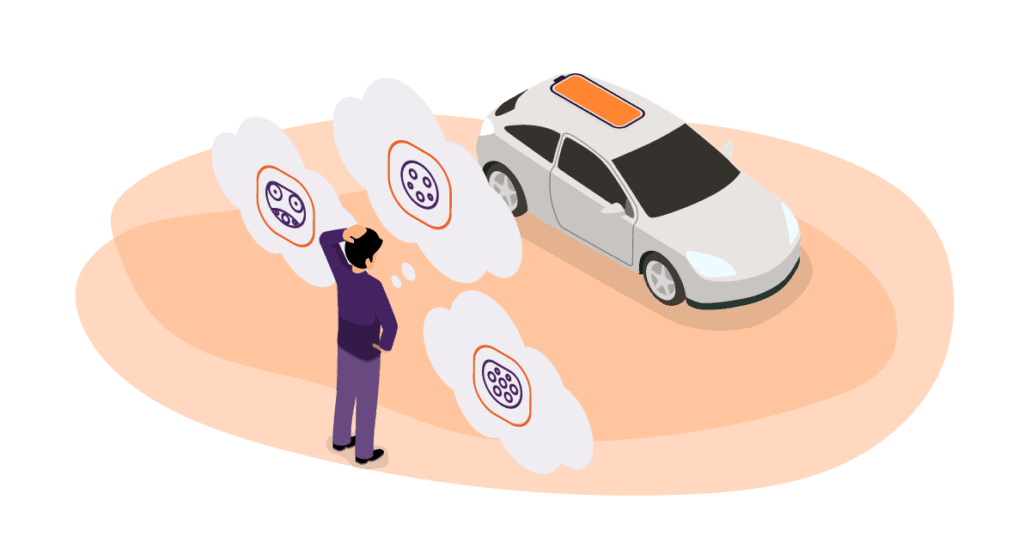Noodoe App
Contact Info
12A, Level 12, 157 Ann St,
Brisbane, Queensland
4000, Australia
Tel: 1800 666 363
info@noodoe.com
12A, Level 12, 157 Ann St,
Brisbane, Queensland
4000, Australia
Tel: 1800 666 363
info@noodoe.com

Last Updated: January 19th, 2023 | E-mobility
Level 1 and Level 2 mean the charging stations provide AC power, and the electric vehicle converts the AC to DC and charges the battery. AC power is more affordable but can require more time to charge vehicles fully.

Mennekes is the Australian (and European) AC standard, also known as the Type 2; this configuration will be most familiar to Aussie EV drivers. The connector has a maximum AC charging capability of 22.1 kW, but the total output depends on the AC inverter of the vehicle. The single-phase inverter's maximum charge speed of 7.2 kW, while the triple-phase inverter's maximum can be 11 kW or 22.1 kW.

Yes, the Tesla connector looks incredibly similar to the Type 2, but that is no mistake. Australian Teslas are deployed with a variation of the standard. Tesla vehicles (with the Tesla port) can charge up with a Mennekes connector. Meanwhile, vehicles from other manufacturers (with the Mennekes port) cannot enjoy the same service at a Tesla charging station. This is because Tesla's charging infrastructure locks out any users who are not part of their club. Tesla also shares the charging capabilities of Type 2, up to 7.2 kW, 11 kW, or 22.1 kW depending on the station and car.
The J1772 is the American standard for many electric vehicles charging stations; it is less common in the Southern hemisphere but can still be found at certain Australian and New Zealand charging sites. This plug is often associated with older-generation electric vehicles or from manufacturers such as Mitsubishi and Nissan. All J1772s are AC charging connectors with 7.2 kW maximum output.
Level 3 charging stations are DC-powered. They are faster and more powerful, with a price point to match. There is no need for an AC/DC inverter; the electricity goes straight to charging the battery for a whole lotta convenience.
The Combined Charging System (CCS) is the standard for fast-charging electric vehicles, although the two versions are unfortunately incompatible. CCS1 is deployed in North America, while CCS2 is in the rest of the world. Much like our units of measurement, Australia's standard is more universal. The CCS2 is available for DC charging; the top half matches the Type 2 (Mennekes) connector's design, while the bottom ports allow further connection for DC rapid charging up to 350 kW.

Most Teslas sold in AU/NZ actually come with the CCS2 port for DC charging sessions. While Tesla's previously mentioned exclusivity leaves other EV drivers high and dry, a recent announcement by the NSW government stated all Tesla supercharging sites built with their funding must be available for all models of electric vehicles. This development will likely lead to more cross-brand charging in Australia. Older Tesla Model S and X vehicles delivered last decade came with the standard Tesla NACS. Here's a look at the usual Tesla port for the interested...
The "Charge to Move" CHAdeMO is a Japanese-developed connector installed in vehicles from automakers such as Nissan, Mitsubishi, Honda, and Toyota. As Japan produces many electric vehicles for the Australian market, it was once a typical fast charging port. However, it is now a dying standard as AU/NZ has adopted the CCS2 connector standard. The current generation of CHAdeMO provides up to 400 kW of charging and can feed electricity back into the power grid.
Now you know the difference between charger ports; you can better plan for your own EV needs. Noodoe chargers are available for deployment and installation in the Australian region; our AC chargers have the Mennekes connector, and our DC range has CCS2 connection possibilities. Noodoe Pty Ltd in Brisbane can offer expert advice and support to any individual or business seeking to join the growing electric vehicle charging infrastructure down under.
| Cookie | Duration | Description |
|---|---|---|
| cookielawinfo-checkbox-analytics | 11 months | This cookie is set by GDPR Cookie Consent plugin. The cookie is used to store the user consent for the cookies in the category "Analytics". |
| cookielawinfo-checkbox-functional | 11 months | The cookie is set by GDPR cookie consent to record the user consent for the cookies in the category "Functional". |
| cookielawinfo-checkbox-necessary | 11 months | This cookie is set by GDPR Cookie Consent plugin. The cookies is used to store the user consent for the cookies in the category "Necessary". |
| cookielawinfo-checkbox-others | 11 months | This cookie is set by GDPR Cookie Consent plugin. The cookie is used to store the user consent for the cookies in the category "Other. |
| cookielawinfo-checkbox-performance | 11 months | This cookie is set by GDPR Cookie Consent plugin. The cookie is used to store the user consent for the cookies in the category "Performance". |
| viewed_cookie_policy | 11 months | The cookie is set by the GDPR Cookie Consent plugin and is used to store whether or not user has consented to the use of cookies. It does not store any personal data. |
